North Sulawesi, Manado - Part 2 : Arrival At Paradise
Manado Dive Travel - 11 to 15 November 2006
Partie Deux de Six
Premier-jour : Saturday, 11 November 2006
Prior to Departure...
A very exciting day for me indeed...
My dad gave Michelle and I a lift to the Airport. We reached 1 and a half hours prior to depature time. I thought it was still early because Michelle took the liberty of checking in online for us the day before so as to expedite the smooth clearance at the airport.
We had breakfast at Polar Cafeteria at the basement of Changi's Terminal 2 while waiting for Alex. He arrived not long after and we proceeded to check in our luggage and dive equipment at Silkair's counter.
It was about 1 hour before flight departure but we were told it was too late to check in the baggage. The ground attendant told us we have to hurry to the gate as it was almost boarding time. So no choice, we got to lug all our heavy and bulky items onboard. We just cleared immigration when it was last call to board. The three of us panicked and threw our stuff on the trolleys and drove it recklessly towards our gate. That damn gate was so far away... we were already rushing through the bustling crowd inside T2 like mad dogs when our gate was closing.... That made me sweat even more.... It took us 10 mins of running to get to Gate 10. That bloody Changi airport was so damn big. What an early morning workout!
When we arrived at gate number 10, there was still a long queue for security clearance. I was like thinking - What the heck! I never knew Changi airport's system to be that "efficient"! Finally boarded the plane for a good 3 hour rest. The flight stewardess lived up to Singapore Airline's reputation. They were friendly and pleasant - some form of consolation i guess...
The flight bounded for Manado was full of "Ang Mos"! I reckoned only 10% were Asians, us inclusive. Most were divers like ourselves because they were also lugging expensive regulator systems and photography equipment onboard.
We arrived at Manado's Sam Ratulangi Airport at the stipulated time. We met Jerry, Barracuda Resort's coordinator and proceed with the 45 mins overland transfer.
Arrival @ Barracuda Diving Resort
We were given a warm welcome by the resort's staff and met our dive guide Noldi who will be showing us the wonders of Manado and Lembeh for the next few days. We quickly settled in and was ushered to our rooms after filling up the necessary paperwork. We opted for a large triple sharing hut further up the hill and to our delight, it was well furnished and maintained. There was a wide private veranda where Alex tied his hammock. The view was perfect as per mentioned in my previous post. Enjoy the scenic views of awesome volcanoes and Manado Bay. Catch the magnificent sun sinking into the horizon turning the waters red-gold with its rays. The cottage hut is a spacious deluxe chalet with a single and a king sized bed. There was also an attached bathroom with hot shower( what our michelle can't live without..) and the room was fully air-conditioned.... There was even a satelite television with DVD player( that can't work... maybe our luck). After we settled in, we hurried down the Jetty for our virgin dive in Manado.
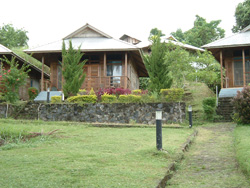



Check Out Dive!
Dive Site: Barracuda Resort's House Reef (Molas Beach)
Location: Manado Bay
Visibilty: 8 m
Temperature: 28°C
Maximum Depth: 20 m
It was low tide and the boat was stuck in the mud. The boat men and Noldi were trying very hard to push the boat out of the shallow mangrove swamp. It was tedious work.
This is getting interesting as I thought. Our first dive was to be done at this swamp full of seagrasses and mangrove roots? It was certainly a first time for me to dive into a mangrove habitat. I really don't know what to expect.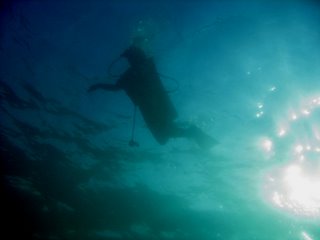 We got on board the boat and it scooted a little further out into deeper waters. Our first descend was so dramatic and erractic. We were blobbing up and down on the surface unable to descend due to bouyant equipment. I tucked at my BC and wet suit to release the trap air and was then able to descend slowly. Whilst desending I suddenly find myself surrounded by lots of "jellyfish" floating in mid water column. Holy cow! On a closer inspection, they were only plastic bags.... I met Alex soon after at the bottom but we can still see Michelle struggling at the surface( yes the visiblity was fairly good for a swamp). Noldi ascended and added more weights to Michelle and she sank like a stone.
We got on board the boat and it scooted a little further out into deeper waters. Our first descend was so dramatic and erractic. We were blobbing up and down on the surface unable to descend due to bouyant equipment. I tucked at my BC and wet suit to release the trap air and was then able to descend slowly. Whilst desending I suddenly find myself surrounded by lots of "jellyfish" floating in mid water column. Holy cow! On a closer inspection, they were only plastic bags.... I met Alex soon after at the bottom but we can still see Michelle struggling at the surface( yes the visiblity was fairly good for a swamp). Noldi ascended and added more weights to Michelle and she sank like a stone.
I was amazed by the house reef's environment. Among the black volcanic sands are coral heads rich with life! The gradually sloping sandy bottom are full of surprises. This muck site poses a challenge especially when it is constantly swept by long shore drift. Good bouyancy is a must as the sand will stir easily when disturbed. Our overly weighted Michelle was having a good time destroying my opportunities at photography. She was stomping through the sand thus creating a trail of a sand storm in her wake! She deposited a heap of sand on the Clark's Anemonefish eggs while I was taking pictures. It made Mummy Nemo really pissed and started attacking me in defence of her clutch of brood.
The parents with their orange-red roes deposited on the log beside the anemone. The female is always the larger and more aggressive of the two. All anemonefish start life as male and gradually grow and change its sex to female to assume the role of dominance in an anemone community. Being highly territorial and feisty, they will be ready to face any perceived threat. They swim up from their host and snap at the intruder boldly when you come too close to their anemone home.
Rhomboid disc, anterior and posterior margins of disc mildly convex. Rostrum grey or tan with blue (occasionally white) spots about eye size and smaller black spots. Tail is about 2 times body length. End of tail is banded with black and white. It likes bury itself in sand or cruises over reef flats looking for crabs and shrimps.
This shrimp looks superficially similar to many other commensal shrimps belonging to the same genus. This species may be readily identified by its transparent body, marked with five white bands, often thinly outlined in red. Chelipeds, antennae, abdominal hump, tail and eyes are also white. The specimen above is a colour variation with a tinge of bluish purple on the edge of its chelipeds and tail. The distinction is its characteristic posture - Methodically and rythmically swaying to and fro its perch, all the while keep its chelipeds in an unmistable "fold arms" pose.
A beautiful shrimp that is marked in bright red and white spots against a transparent livery. It oftens float motionlessly in the water column maintaining neutral bouyancy and boldly approach visiting fishes and photographers alike to clean them.
This is a highly specialised cleaner shrimp whose preferred clients are in particular groupers and morays. It will often enter gill openings and go inside gaping mouth of the fish to remove scraps of food and decaying matter. They sometimes congregate in large groups and are easily recognised by its red and yellowish body with a bright white dorsal stripe. The antennae are also recognisably longer than its body length and are distinctively white.
This tiny guy was found by Noldi's eagle eyes.... completely blended in with the pinkish orange sponge of genus Xestospongia which it exclusively live on. Underwater, it looks drab and dull orange brown. But once illuminated with white light, it reveals its true neon-pink colouration. The body and legs are striped in bright flourescent purple and covered with long white and pink bristles.
Closer frontal shot... This cute hairy guy elicits great admiration and is so small that a super macro lens will be needed to properly get a good set of enlargement. They are usually found in pairs on Xestospongia barrels.
Trapezia species like this cute tiny guy are usually found among branching hard coral colonies. This species is almost exclusively found among Seriotopora hystrix ramifications and can be identified by the bright white spots visible on the inside of each arm when feeding. Take a closer look and you'll see their distinct spotted legs.
This is still an undescribed species of the Nudibranchia Janolus. It belong to the family of Zephyrinidae and of suborder Arminina. Species of Janolus are bryozoan feeders.
Both the Chromodoris geometrica and Chromodoris reticulata belonged to the same family of Chromodorididae.
Chromodoris geometrica has an interesting mimicry of its Phyllidiid cousins to ward of predators. Nudibranchs in Phyllidiidae have the capabilities of exuding very noxious and toxic chemical irritants from their when harrassed and appear to be avoided by most fish. They are often the only sea slugs which blatantly crawl out in the open during the day. Apart from the characteristic dorsal colour pattern, which resembles a Phyllidiid, this species is one of a group with a fairly large anterior mantle skirt which waves up and down as the animal crawls along, and is purple on its underside.
Chromodoris reticulata is actually a colour variation of Chromodoris tinctoria. In the reticulated Chromodoris it is lacking a yellow margin around the edge of its mantle skirt. Internal anatomy suggests that both are actually the same species.
This Nudibranch is of the Dorididae family. Its distinctively ridged body made its identification as a Halgerda easy. The pink translucent body, veined in orange and speckled with bright orange spots on ridge summit made it a very photogenic subject. Its rhinopores and gills are also differently marked in brownish black spots.
Can be easily overlooked due to their amazing camouflage. Leaf-thin in section, they tend to stay still, often swaying like a decaying vegetation in the currents. If threatened, they will clumsily and slowly "hop" along, literally walking with their paddle-like pectoral fins. They come in an array of colours from bright white, reddish brown, lemon yellow, lime green and even bright fuchsia. They are ambush predators and they belong to the family of Scorpaenidae along with stonefish and lionfish. So never ever touch them unless you want to get yourself inflicted with their poisonous spines.
An adolescent P. volitans lionfish. This is the typical dark brown (red) color morph. The striping pattern varies on almost all of these fish. What is noteworthy is that the center of the pectoral fins is almost translucent and bright white spotted. Also, Volitans lionfish have multiple mandibular projections, and two ruffled ocular projections.
The Fu Manchu name comes from the large skin flaps, or whiskers hanging down from either side of its mouth and looking very much like a Fu Manchu mustache. The Twinspot name comes from two dark eyespots ringed with yellow and red that occur on the dorsal fin just above the caudal peduncle.
Antennata lions are beautifully marked with alternating vertical bands of reds, whites, and browns, and are readily identified by their long, white free rays of the pectoral fins which possess webbing that connects only halfway up the fin ray. This membranous area has one or beautiful dark blue spots resembling eyespots. The posterior portion of each fin ray is whitish and extends to past the caudal peduncle on the ventral portion of the pectoral fin; each fin ray is independent and not connected by webbing. They also have frilled( not leaf-shaped) tentacles above the eyes.
Adult Starry Pufferfish are white with numerous small black spots that become relatively smaller and more numerous as the fish grows. Juveniles are orange with small black spots. They have diagonal black bands crossing the abdomen. This species grows to 1.2 m in length. It has a variable diet that can include sea urchins, crustaceans, sponges, coral and algae. The Starry Pufferfish occurs in tropical marine waters of the Indo-Pacific. This huge specimen of about 1 m in length was resting lazily on the sandy bottom... very easy to approach.
Unmistakable yellow-lined livery with reddish pipe snout and a networked of fine black vein-like lines marking longitudinally along its body length.
A beautiful, free swimming and active species. Often in pairs or in loose congregations near the base of boulders and rocky slopes, especially where there are long-spined sea urchins. They like to seek refuge between the spines to escape predators.
Michellea, a very "disgusting" species that is fairly common underwater. I have seen her twice this year underwater at Sipadan and Manado. She spot a pair of distinct neon yellow fins that made her easy to identify. Always seen with a greyish dull "Mares" livery, she swims rather clumsily along sandy bottom but can hover efficiently in mid water column. She doesn't like small critters and hates Nudibranchs. She also hates thermocline and prefers warm calm waters to current swept cold conditions. She also likes to dwell near wrecks.
Alexus is also commonly known as the Green-ass monster. Contrary to his name, this green butt creature is non-aggressive in nature. In fact he is always ready to pose funnily for the camera whenever there's opportunity. Bouyancy of this creature is very good. There is no problem for him hovering just above sandy bottoms. He has a pair of keen eyes for macro subjects but prefers the deep blue to muck sandy sites because of his thirst for bigger pelagics.
Night Dive!
Dive Site: Black Rock (Batu Hitam)
Location: Manado Bay
Visibilty: 5 m
Temperature: 26°C-28°C
Maximum Depth: 20 m
Rest and relax...
Partie Deux de Six
Premier-jour : Saturday, 11 November 2006
Prior to Departure...
A very exciting day for me indeed...
My dad gave Michelle and I a lift to the Airport. We reached 1 and a half hours prior to depature time. I thought it was still early because Michelle took the liberty of checking in online for us the day before so as to expedite the smooth clearance at the airport.
We had breakfast at Polar Cafeteria at the basement of Changi's Terminal 2 while waiting for Alex. He arrived not long after and we proceeded to check in our luggage and dive equipment at Silkair's counter.
It was about 1 hour before flight departure but we were told it was too late to check in the baggage. The ground attendant told us we have to hurry to the gate as it was almost boarding time. So no choice, we got to lug all our heavy and bulky items onboard. We just cleared immigration when it was last call to board. The three of us panicked and threw our stuff on the trolleys and drove it recklessly towards our gate. That damn gate was so far away... we were already rushing through the bustling crowd inside T2 like mad dogs when our gate was closing.... That made me sweat even more.... It took us 10 mins of running to get to Gate 10. That bloody Changi airport was so damn big. What an early morning workout!
When we arrived at gate number 10, there was still a long queue for security clearance. I was like thinking - What the heck! I never knew Changi airport's system to be that "efficient"! Finally boarded the plane for a good 3 hour rest. The flight stewardess lived up to Singapore Airline's reputation. They were friendly and pleasant - some form of consolation i guess...
The flight bounded for Manado was full of "Ang Mos"! I reckoned only 10% were Asians, us inclusive. Most were divers like ourselves because they were also lugging expensive regulator systems and photography equipment onboard.
We arrived at Manado's Sam Ratulangi Airport at the stipulated time. We met Jerry, Barracuda Resort's coordinator and proceed with the 45 mins overland transfer.
Arrival @ Barracuda Diving Resort
We were given a warm welcome by the resort's staff and met our dive guide Noldi who will be showing us the wonders of Manado and Lembeh for the next few days. We quickly settled in and was ushered to our rooms after filling up the necessary paperwork. We opted for a large triple sharing hut further up the hill and to our delight, it was well furnished and maintained. There was a wide private veranda where Alex tied his hammock. The view was perfect as per mentioned in my previous post. Enjoy the scenic views of awesome volcanoes and Manado Bay. Catch the magnificent sun sinking into the horizon turning the waters red-gold with its rays. The cottage hut is a spacious deluxe chalet with a single and a king sized bed. There was also an attached bathroom with hot shower( what our michelle can't live without..) and the room was fully air-conditioned.... There was even a satelite television with DVD player( that can't work... maybe our luck). After we settled in, we hurried down the Jetty for our virgin dive in Manado.





Check Out Dive!
Dive Site: Barracuda Resort's House Reef (Molas Beach)
Location: Manado Bay
Visibilty: 8 m
Temperature: 28°C
Maximum Depth: 20 m
It was low tide and the boat was stuck in the mud. The boat men and Noldi were trying very hard to push the boat out of the shallow mangrove swamp. It was tedious work.
This is getting interesting as I thought. Our first dive was to be done at this swamp full of seagrasses and mangrove roots? It was certainly a first time for me to dive into a mangrove habitat. I really don't know what to expect.
 We got on board the boat and it scooted a little further out into deeper waters. Our first descend was so dramatic and erractic. We were blobbing up and down on the surface unable to descend due to bouyant equipment. I tucked at my BC and wet suit to release the trap air and was then able to descend slowly. Whilst desending I suddenly find myself surrounded by lots of "jellyfish" floating in mid water column. Holy cow! On a closer inspection, they were only plastic bags.... I met Alex soon after at the bottom but we can still see Michelle struggling at the surface( yes the visiblity was fairly good for a swamp). Noldi ascended and added more weights to Michelle and she sank like a stone.
We got on board the boat and it scooted a little further out into deeper waters. Our first descend was so dramatic and erractic. We were blobbing up and down on the surface unable to descend due to bouyant equipment. I tucked at my BC and wet suit to release the trap air and was then able to descend slowly. Whilst desending I suddenly find myself surrounded by lots of "jellyfish" floating in mid water column. Holy cow! On a closer inspection, they were only plastic bags.... I met Alex soon after at the bottom but we can still see Michelle struggling at the surface( yes the visiblity was fairly good for a swamp). Noldi ascended and added more weights to Michelle and she sank like a stone.I was amazed by the house reef's environment. Among the black volcanic sands are coral heads rich with life! The gradually sloping sandy bottom are full of surprises. This muck site poses a challenge especially when it is constantly swept by long shore drift. Good bouyancy is a must as the sand will stir easily when disturbed. Our overly weighted Michelle was having a good time destroying my opportunities at photography. She was stomping through the sand thus creating a trail of a sand storm in her wake! She deposited a heap of sand on the Clark's Anemonefish eggs while I was taking pictures. It made Mummy Nemo really pissed and started attacking me in defence of her clutch of brood.
The parents with their orange-red roes deposited on the log beside the anemone. The female is always the larger and more aggressive of the two. All anemonefish start life as male and gradually grow and change its sex to female to assume the role of dominance in an anemone community. Being highly territorial and feisty, they will be ready to face any perceived threat. They swim up from their host and snap at the intruder boldly when you come too close to their anemone home.
Rhomboid disc, anterior and posterior margins of disc mildly convex. Rostrum grey or tan with blue (occasionally white) spots about eye size and smaller black spots. Tail is about 2 times body length. End of tail is banded with black and white. It likes bury itself in sand or cruises over reef flats looking for crabs and shrimps.
This shrimp looks superficially similar to many other commensal shrimps belonging to the same genus. This species may be readily identified by its transparent body, marked with five white bands, often thinly outlined in red. Chelipeds, antennae, abdominal hump, tail and eyes are also white. The specimen above is a colour variation with a tinge of bluish purple on the edge of its chelipeds and tail. The distinction is its characteristic posture - Methodically and rythmically swaying to and fro its perch, all the while keep its chelipeds in an unmistable "fold arms" pose.
A beautiful shrimp that is marked in bright red and white spots against a transparent livery. It oftens float motionlessly in the water column maintaining neutral bouyancy and boldly approach visiting fishes and photographers alike to clean them.
This is a highly specialised cleaner shrimp whose preferred clients are in particular groupers and morays. It will often enter gill openings and go inside gaping mouth of the fish to remove scraps of food and decaying matter. They sometimes congregate in large groups and are easily recognised by its red and yellowish body with a bright white dorsal stripe. The antennae are also recognisably longer than its body length and are distinctively white.
This tiny guy was found by Noldi's eagle eyes.... completely blended in with the pinkish orange sponge of genus Xestospongia which it exclusively live on. Underwater, it looks drab and dull orange brown. But once illuminated with white light, it reveals its true neon-pink colouration. The body and legs are striped in bright flourescent purple and covered with long white and pink bristles.
Closer frontal shot... This cute hairy guy elicits great admiration and is so small that a super macro lens will be needed to properly get a good set of enlargement. They are usually found in pairs on Xestospongia barrels.
Trapezia species like this cute tiny guy are usually found among branching hard coral colonies. This species is almost exclusively found among Seriotopora hystrix ramifications and can be identified by the bright white spots visible on the inside of each arm when feeding. Take a closer look and you'll see their distinct spotted legs.
This is still an undescribed species of the Nudibranchia Janolus. It belong to the family of Zephyrinidae and of suborder Arminina. Species of Janolus are bryozoan feeders.
Both the Chromodoris geometrica and Chromodoris reticulata belonged to the same family of Chromodorididae.
Chromodoris geometrica has an interesting mimicry of its Phyllidiid cousins to ward of predators. Nudibranchs in Phyllidiidae have the capabilities of exuding very noxious and toxic chemical irritants from their when harrassed and appear to be avoided by most fish. They are often the only sea slugs which blatantly crawl out in the open during the day. Apart from the characteristic dorsal colour pattern, which resembles a Phyllidiid, this species is one of a group with a fairly large anterior mantle skirt which waves up and down as the animal crawls along, and is purple on its underside.
Chromodoris reticulata is actually a colour variation of Chromodoris tinctoria. In the reticulated Chromodoris it is lacking a yellow margin around the edge of its mantle skirt. Internal anatomy suggests that both are actually the same species.
This Nudibranch is of the Dorididae family. Its distinctively ridged body made its identification as a Halgerda easy. The pink translucent body, veined in orange and speckled with bright orange spots on ridge summit made it a very photogenic subject. Its rhinopores and gills are also differently marked in brownish black spots.
Can be easily overlooked due to their amazing camouflage. Leaf-thin in section, they tend to stay still, often swaying like a decaying vegetation in the currents. If threatened, they will clumsily and slowly "hop" along, literally walking with their paddle-like pectoral fins. They come in an array of colours from bright white, reddish brown, lemon yellow, lime green and even bright fuchsia. They are ambush predators and they belong to the family of Scorpaenidae along with stonefish and lionfish. So never ever touch them unless you want to get yourself inflicted with their poisonous spines.
An adolescent P. volitans lionfish. This is the typical dark brown (red) color morph. The striping pattern varies on almost all of these fish. What is noteworthy is that the center of the pectoral fins is almost translucent and bright white spotted. Also, Volitans lionfish have multiple mandibular projections, and two ruffled ocular projections.
The Fu Manchu name comes from the large skin flaps, or whiskers hanging down from either side of its mouth and looking very much like a Fu Manchu mustache. The Twinspot name comes from two dark eyespots ringed with yellow and red that occur on the dorsal fin just above the caudal peduncle.
Antennata lions are beautifully marked with alternating vertical bands of reds, whites, and browns, and are readily identified by their long, white free rays of the pectoral fins which possess webbing that connects only halfway up the fin ray. This membranous area has one or beautiful dark blue spots resembling eyespots. The posterior portion of each fin ray is whitish and extends to past the caudal peduncle on the ventral portion of the pectoral fin; each fin ray is independent and not connected by webbing. They also have frilled( not leaf-shaped) tentacles above the eyes.
Adult Starry Pufferfish are white with numerous small black spots that become relatively smaller and more numerous as the fish grows. Juveniles are orange with small black spots. They have diagonal black bands crossing the abdomen. This species grows to 1.2 m in length. It has a variable diet that can include sea urchins, crustaceans, sponges, coral and algae. The Starry Pufferfish occurs in tropical marine waters of the Indo-Pacific. This huge specimen of about 1 m in length was resting lazily on the sandy bottom... very easy to approach.
Unmistakable yellow-lined livery with reddish pipe snout and a networked of fine black vein-like lines marking longitudinally along its body length.
A beautiful, free swimming and active species. Often in pairs or in loose congregations near the base of boulders and rocky slopes, especially where there are long-spined sea urchins. They like to seek refuge between the spines to escape predators.
Michellea, a very "disgusting" species that is fairly common underwater. I have seen her twice this year underwater at Sipadan and Manado. She spot a pair of distinct neon yellow fins that made her easy to identify. Always seen with a greyish dull "Mares" livery, she swims rather clumsily along sandy bottom but can hover efficiently in mid water column. She doesn't like small critters and hates Nudibranchs. She also hates thermocline and prefers warm calm waters to current swept cold conditions. She also likes to dwell near wrecks.
Alexus is also commonly known as the Green-ass monster. Contrary to his name, this green butt creature is non-aggressive in nature. In fact he is always ready to pose funnily for the camera whenever there's opportunity. Bouyancy of this creature is very good. There is no problem for him hovering just above sandy bottoms. He has a pair of keen eyes for macro subjects but prefers the deep blue to muck sandy sites because of his thirst for bigger pelagics.
Night Dive!
Dive Site: Black Rock (Batu Hitam)
Location: Manado Bay
Visibilty: 5 m
Temperature: 26°C-28°C
Maximum Depth: 20 m
It was already very dark at 6pm. It is like 8pm in Singapore. Strange thing is that North Sulawesi is in the same time zone as Singapore but has got different sunrise and sun set times.
There were no lights on the boat and it was so freakin' dark...... we were all stumbling to find our equipment and to gear up.
It was just a short 5 mins boat ride out to Black rock. We eagerly got into the water and commenced our night time adventure....
On first descend, it was right below us! We all but Michelle saw it. It was resting motionlessly on the sandy seabed and none of my buddies seemed to be interested in it. It was my first Flying Gurnard and therefore, I had to see its flight display. I came close to it deliberately alarming it but not overly molested. It started to flare its enormous, brilliantly coloured pectoral fins and at the same time, raising its dorsal spine above its head while taking flight. It elegantly glided away in a zig zig fashion. It is an almost perfect disc-like shape when seen above. It is a hunter of gobies and some crustaceans. The layman rarely realises this species is closely related to true scorpionfish.
Note its uniquely frilled antenna and its pair of beautifully blue spotted pectoral fins.
This is the Juvenile of the common lionfish. The juveniles are often exquiste in their colour and body markings. This tiny individual is decorated with exagerating large spots on its almost transparent pectorals fins.
This tiny specimen is a juvenile of the Harlequin Sweetlips. Juvenile Harlequin Sweetlips under 7-8cm in length, are brown with large dark-edged, white spots. They swim with the head pointing down and with exaggerated fin movements resulting in an undulating motion. At this size the Harlequin Sweetlips is believed to be mimicking a poisonous nudibranch or flatworm to escape predatory. As juveniles grow, the brown base colour disappears and dark brown spots develop. Adults are white with dark brown spots on the body and fins. Harlequin Sweetlips grow to 60cm in length. Juveniles live in lagoons, but adults live in deeper water and are often observed under ledges or in caves.
This small fish of only about 1cm was undulating and desperately trying to hide under the coral. Judging from its black and white striped livery and an elongated dorsal anterior fin, this does look like the juveniles of some Drums and Jacknife fishes.
My first ornate ghost pipefish encounter! It is one of the most beautiful, fascinating and sought after macro species. Its colouration is highly variable, but usually very striking and with large stripes and spots of yellow, white, black, red and blue. They are often found associated to crinoids and gorgonians.
This is one of the easiest to identify species of moray eels. Distinguished by its lemon yellow, dark-spotted head, its elongated snout and its very freckled pale white body. Ots behaviour does not differ considerably from that of other moray species. They are not aggressive and will invariably retreat into their lair if closely approached.
They are gregarious, often found in dense ball-like schools, steam-rolling over the sandy bottom in search of food. Striped Catfish like all other catfish, possess venomous spines and this species in particular are capable of inflicting extremely painful injuries or even cause death!
A beautiful and very compliant photo subject. It is the most commonly encountered and observed cleaner shrimp in tropical waters.
Its spectacular red and white coloured bands makes it highly visible and advertises its cleaning services to would be customers, giving it a degree of safety from riving predators. They are bold species often staying out of their holes and waving its long antennae to entice passing fish to stop by for some good cleaning service.
A huge species, living in monogamous pairs in burrows dug in the substrate. Front parts are speckled (and completely blended in with the sand colour) while the rest of its body is banded. This species is a "spearer", capable of impaling a fish on its specially evolved raptorial claws in a 3 millisecond strike! As with other Mantis shrimps, they can inflict serious and severe wounds if man-handled.
Also known as deep sea Squat Lobsters, they usually live outside the range of recreational divers. This species however, as uncomon as it is and on rare occasions, can be encountered within our recreational depth. It is a very interesting, colourful and extremely long-legged crab and is rarely observed while it perches in full sight on large gorgonian fans in current prone areas. Count myself lucky, this spidey crab was indeed an unusual find and it posed boldly for my camera.
I got no reference to this creature. There were 4 or 5 of them crawling around a sponge so I reckoned they are quite common in local waters. It has a typical spread of its long legs like those of spider crab. Its bristled frontal legs somewhat looked like modified claws for spearing its prey and clinging on to them tightly. It is also armed with a pair of chelipeds (frontal pincers) like most squat lobsters and crabs but unlike them, its body is slim and elongated. Last but not least, this guy has a head with an uncanny resemblance to its anthropod counterpart on land - a red army ant.
Easily recognised by the multitudes of round red spots on a pinkish white background. This tiny female was captured with roes underneath its belly. This tiny species live exclusively among the branching colonies of the Pocillopora hard corals.
An unsurpassed master of camouflage, usually completely covered with bits of debris - including living organisms like sponges, hydroids and algae - and slowly, clumsily moving among rubble. It is quite imposible to make out from the background if it's not moving around, and even then really difficult to see.
A large Tropical Sponge Crab moved across the coral reef at night carrying a sponge as cover.
This crab has a furry carapace and white tipped claws, typical of this species.
This nudibranch is of the family Polyceridae. It has 3 feathery sets of gills (characteristic of the Nembrotha) capable of retracting when disturbed. This tiny specimen was only about 1 cm. Had a hard time locking focus on this one.
Typical shape for the genus with a broad, thin, leathery mantle skirt and raised crenulate rhinophore and gill pockets. Mantle brown with small raise white tubercles. Around the mantle edge is a cream to yellowish marginal band and a dark reddish brown submarginal band. On the inside of this brown band there is sometimes a continuation of the yellowish margin, and sometimes a translucent white band which gradually diffuses into the brown background. Usually there are scattered white spots, ringed with dark brown, on the mantle. In some specimens these are large and prominent, while in other specimens they are small and inconspicuous.
Its gills retracted into its pocket after i came too close..... Resembles a large flatworm with it gill retracted but it is an ophistobranch of the order, Nudibrachia and belongs to family, Dorididae.
Lavender blue in colour, with a longitudinal stripe along the midline. The stripe is mainly white, orange anteriorly, and with a purple edge posteriorly. Mainly feeding on colonial ascidians, extruding tubules from the pharynges and attacking simultaneously the inner organs of different zooids.
Cowries are a type of mollusc that have very smooth, shiny and beautifully patterned shells. Their soft elastic mantle often extend to cover the entire exterior of its shell during feeding and retract into the relative safety of their hard housing when threatened, revealing the beauty of mother nature's work. Their survival is highly threatened due to the excessive collection of the shells. Well Mr Alex happened to collect one such shell during our adventures underwater... thankfully the shell has got no occupant.
There were no lights on the boat and it was so freakin' dark...... we were all stumbling to find our equipment and to gear up.
It was just a short 5 mins boat ride out to Black rock. We eagerly got into the water and commenced our night time adventure....
On first descend, it was right below us! We all but Michelle saw it. It was resting motionlessly on the sandy seabed and none of my buddies seemed to be interested in it. It was my first Flying Gurnard and therefore, I had to see its flight display. I came close to it deliberately alarming it but not overly molested. It started to flare its enormous, brilliantly coloured pectoral fins and at the same time, raising its dorsal spine above its head while taking flight. It elegantly glided away in a zig zig fashion. It is an almost perfect disc-like shape when seen above. It is a hunter of gobies and some crustaceans. The layman rarely realises this species is closely related to true scorpionfish.
Note its uniquely frilled antenna and its pair of beautifully blue spotted pectoral fins.
This is the Juvenile of the common lionfish. The juveniles are often exquiste in their colour and body markings. This tiny individual is decorated with exagerating large spots on its almost transparent pectorals fins.
This tiny specimen is a juvenile of the Harlequin Sweetlips. Juvenile Harlequin Sweetlips under 7-8cm in length, are brown with large dark-edged, white spots. They swim with the head pointing down and with exaggerated fin movements resulting in an undulating motion. At this size the Harlequin Sweetlips is believed to be mimicking a poisonous nudibranch or flatworm to escape predatory. As juveniles grow, the brown base colour disappears and dark brown spots develop. Adults are white with dark brown spots on the body and fins. Harlequin Sweetlips grow to 60cm in length. Juveniles live in lagoons, but adults live in deeper water and are often observed under ledges or in caves.
This small fish of only about 1cm was undulating and desperately trying to hide under the coral. Judging from its black and white striped livery and an elongated dorsal anterior fin, this does look like the juveniles of some Drums and Jacknife fishes.
My first ornate ghost pipefish encounter! It is one of the most beautiful, fascinating and sought after macro species. Its colouration is highly variable, but usually very striking and with large stripes and spots of yellow, white, black, red and blue. They are often found associated to crinoids and gorgonians.
This is one of the easiest to identify species of moray eels. Distinguished by its lemon yellow, dark-spotted head, its elongated snout and its very freckled pale white body. Ots behaviour does not differ considerably from that of other moray species. They are not aggressive and will invariably retreat into their lair if closely approached.
They are gregarious, often found in dense ball-like schools, steam-rolling over the sandy bottom in search of food. Striped Catfish like all other catfish, possess venomous spines and this species in particular are capable of inflicting extremely painful injuries or even cause death!
A beautiful and very compliant photo subject. It is the most commonly encountered and observed cleaner shrimp in tropical waters.
Its spectacular red and white coloured bands makes it highly visible and advertises its cleaning services to would be customers, giving it a degree of safety from riving predators. They are bold species often staying out of their holes and waving its long antennae to entice passing fish to stop by for some good cleaning service.
A huge species, living in monogamous pairs in burrows dug in the substrate. Front parts are speckled (and completely blended in with the sand colour) while the rest of its body is banded. This species is a "spearer", capable of impaling a fish on its specially evolved raptorial claws in a 3 millisecond strike! As with other Mantis shrimps, they can inflict serious and severe wounds if man-handled.
Also known as deep sea Squat Lobsters, they usually live outside the range of recreational divers. This species however, as uncomon as it is and on rare occasions, can be encountered within our recreational depth. It is a very interesting, colourful and extremely long-legged crab and is rarely observed while it perches in full sight on large gorgonian fans in current prone areas. Count myself lucky, this spidey crab was indeed an unusual find and it posed boldly for my camera.
I got no reference to this creature. There were 4 or 5 of them crawling around a sponge so I reckoned they are quite common in local waters. It has a typical spread of its long legs like those of spider crab. Its bristled frontal legs somewhat looked like modified claws for spearing its prey and clinging on to them tightly. It is also armed with a pair of chelipeds (frontal pincers) like most squat lobsters and crabs but unlike them, its body is slim and elongated. Last but not least, this guy has a head with an uncanny resemblance to its anthropod counterpart on land - a red army ant.
Easily recognised by the multitudes of round red spots on a pinkish white background. This tiny female was captured with roes underneath its belly. This tiny species live exclusively among the branching colonies of the Pocillopora hard corals.
An unsurpassed master of camouflage, usually completely covered with bits of debris - including living organisms like sponges, hydroids and algae - and slowly, clumsily moving among rubble. It is quite imposible to make out from the background if it's not moving around, and even then really difficult to see.
A large Tropical Sponge Crab moved across the coral reef at night carrying a sponge as cover.
This crab has a furry carapace and white tipped claws, typical of this species.
This nudibranch is of the family Polyceridae. It has 3 feathery sets of gills (characteristic of the Nembrotha) capable of retracting when disturbed. This tiny specimen was only about 1 cm. Had a hard time locking focus on this one.
Typical shape for the genus with a broad, thin, leathery mantle skirt and raised crenulate rhinophore and gill pockets. Mantle brown with small raise white tubercles. Around the mantle edge is a cream to yellowish marginal band and a dark reddish brown submarginal band. On the inside of this brown band there is sometimes a continuation of the yellowish margin, and sometimes a translucent white band which gradually diffuses into the brown background. Usually there are scattered white spots, ringed with dark brown, on the mantle. In some specimens these are large and prominent, while in other specimens they are small and inconspicuous.
Its gills retracted into its pocket after i came too close..... Resembles a large flatworm with it gill retracted but it is an ophistobranch of the order, Nudibrachia and belongs to family, Dorididae.
Lavender blue in colour, with a longitudinal stripe along the midline. The stripe is mainly white, orange anteriorly, and with a purple edge posteriorly. Mainly feeding on colonial ascidians, extruding tubules from the pharynges and attacking simultaneously the inner organs of different zooids.
Cowries are a type of mollusc that have very smooth, shiny and beautifully patterned shells. Their soft elastic mantle often extend to cover the entire exterior of its shell during feeding and retract into the relative safety of their hard housing when threatened, revealing the beauty of mother nature's work. Their survival is highly threatened due to the excessive collection of the shells. Well Mr Alex happened to collect one such shell during our adventures underwater... thankfully the shell has got no occupant.
Rest and relax...
We were famished after the dives and tucked into the sumptous Minahasa styled cuisine. God, the chilli was deliciously spicy!! While we were having dinner, a large Mangrove Crab crawled out from Alex's dive bag across the dining hall.... without much hestitation, I grabbed my camera and took snap shots of that delicious looking critter. It scooted hurriedly into the bushes.
 This is a mother with her clutch of unhatched brood... Look delicious and all meaty but poisonous to consume...
This is a mother with her clutch of unhatched brood... Look delicious and all meaty but poisonous to consume...We were fascinated by a large 1 string instrument that the folks there DIY.... Alex being apt at playing all these stringed musical instruments performed a brief tune that sounded really good to the ear. We had a game of pool before retiring to our rooms.
The pathway leading back to our cottage was full of croaking "Gua" (as michelle termed it) hopping around at night... Rhe way was dimly lit and it freaked the life our of our Ms Disgusting... We had a good refreshing bath before we excitedly logged our dives for the day. We slept early that night looking forward to and anticipating the excitement for the following day!
To be continued.... Day 2: Bunaken diving, Pgymies and the Mandarins display on part trois!
Labels: Trip Report


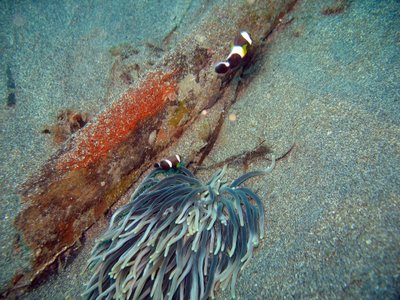




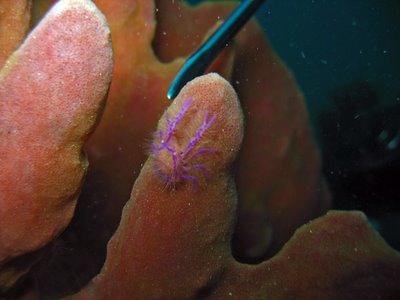

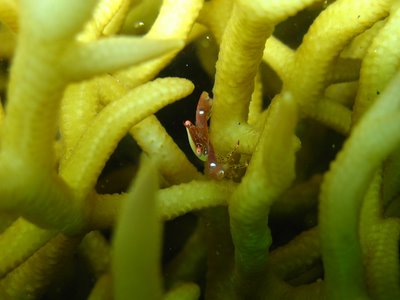
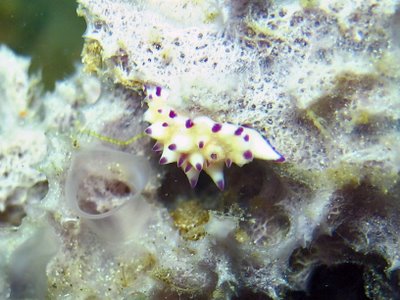

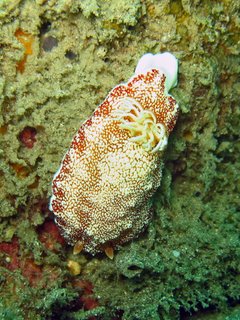

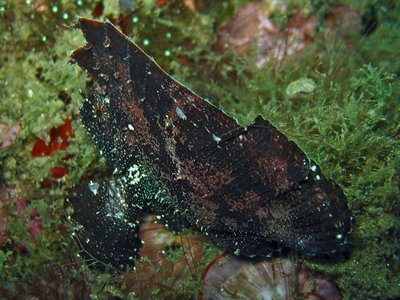
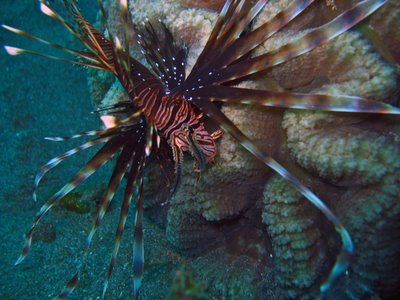
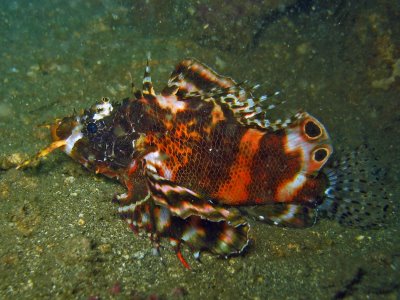
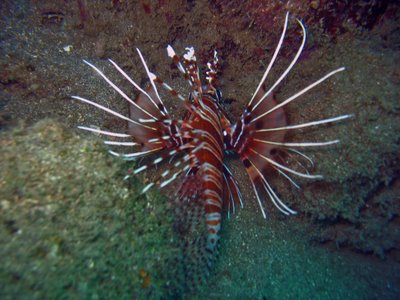
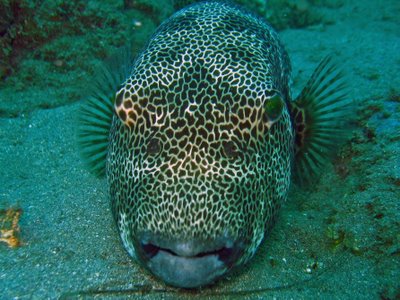
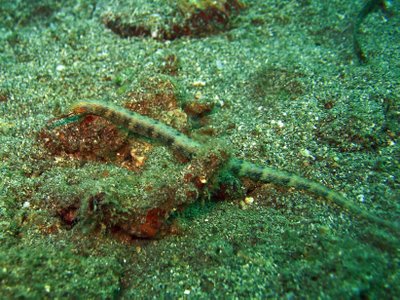




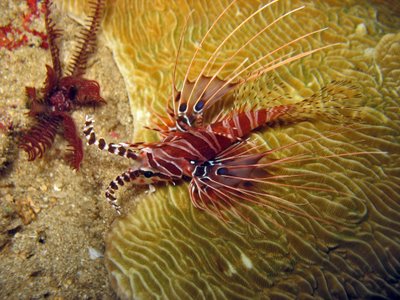

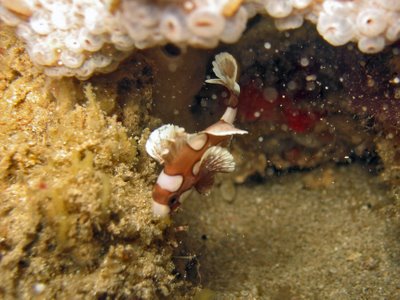

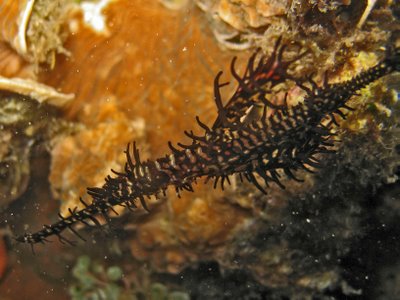
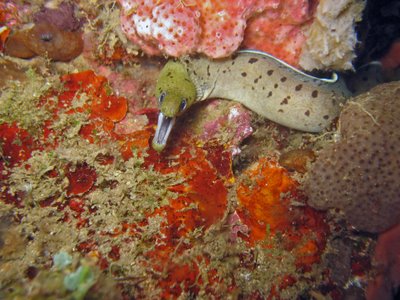
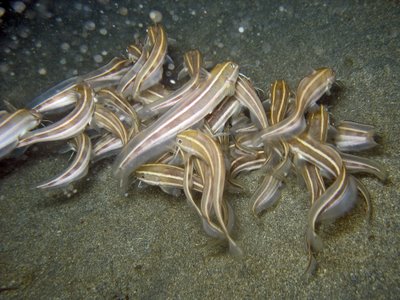
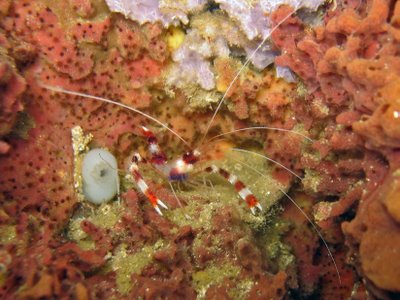




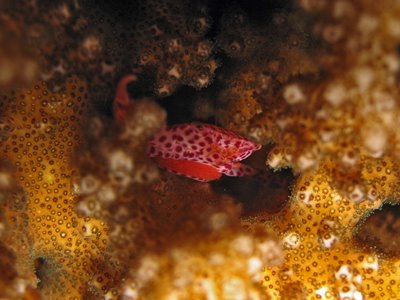

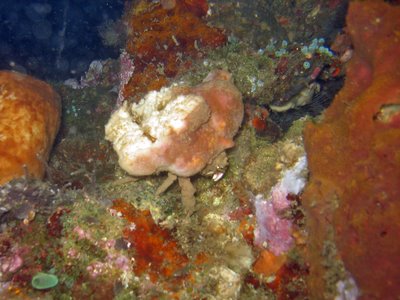
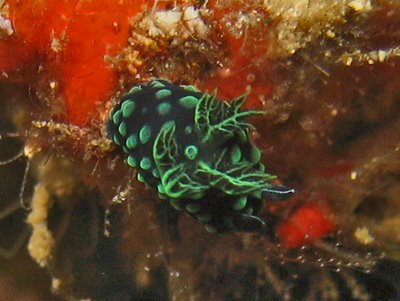
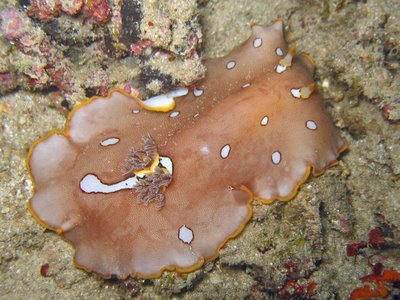
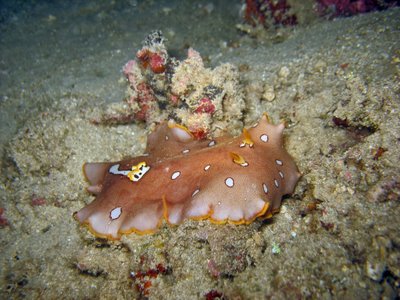

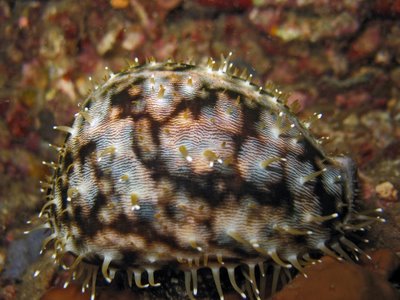
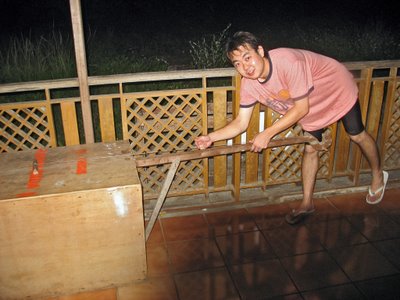




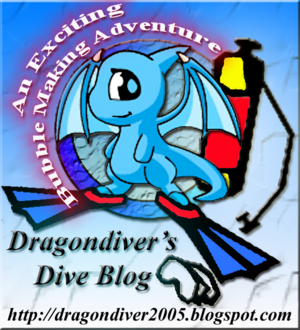




















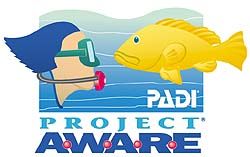


0 Bubbles Created:
Post a Comment
<< Home